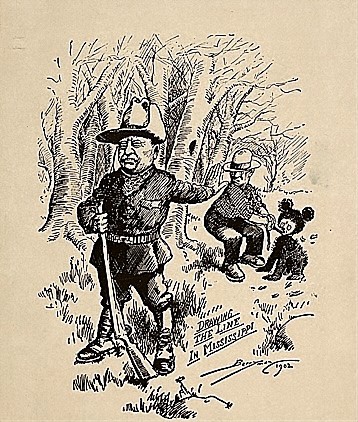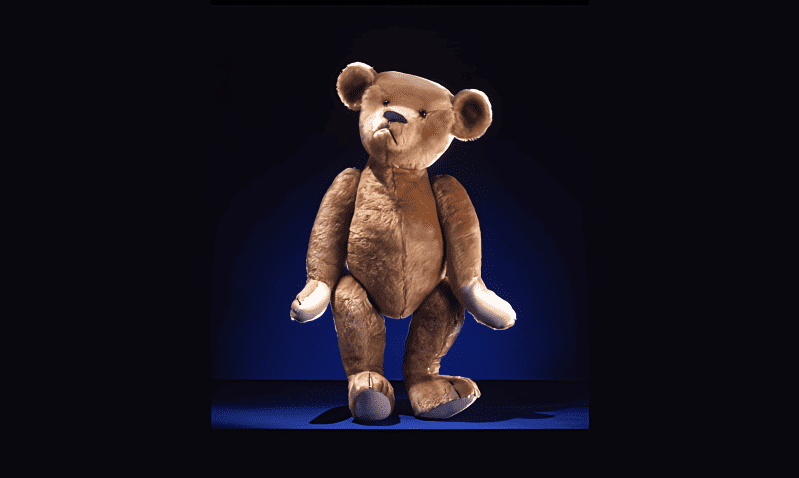Those who read this probably include some bear hunters, so I’ve got a story for you and for just about everyone, for that matter. There are lots of bears out there, and some of them live in our neck of the woods. My short story today involves two bears: One real bear, which was hurt and frightened, and many toy bears, which, among other roles, soothed many who were hurt and frightened. I guess my story here could also be called A Tale of Two Bears, but in reality, it’s the enduring legacy of one frightened little bear.
The two bears’ emergence into our culture came quite by accident, you might say. Our story begins in a most unexpected way in November 1902. The states of Mississippi and Louisiana had a disagreement over the location of their common boundary, which bisected some of the least well-developed land in the United States. The governors of both states invited President Theodore Roosevelt to arbitrate the dispute. Roosevelt decided to combine his tour of the disputed territory with a five-day black bear hunt. The president was having unusually bad luck on his hunt, and as the end was drawing near one of his guides, Holt Collier, decided to wound a small bear he had located so that the president could shoot it and claim a kill. In response, the president flat-out refused. Having shot grizzly bears out west, he could not bring himself to take unfair advantage of a terrified, trapped animal. The President is rumored to have said, “I’ve hunted game all over America, and I’m proud to be a hunter. But I couldn’t be proud of myself if I shot an old, tired, worn-out bear that was tied to a tree.”
Well, it wasn’t long before this story made its way out of Mississippi and into newspapers. One of the first, if not the first, was to cartoonist Clifford Berryman. He wasted no time in drawing and publishing a picture in the Washington Post newspaper of the president turning away in disgust from the idea of shooting a helpless bear. The cartoon was titled “Drawing the Line in Mississippi”(see illustration below), and it endeared much of America to the president. Soon, the story grew a life of its own and spread like wildfire, including to two Russian-Jewish immigrants, Morris and Rose Michtom. They owned and operated a candy store in Brooklyn, New York, and came up with an idea. They also sold stuffed animals in their store, so after seeing Berryman’s drawing, Michtom created a small plush bear cub and sent it to the president, seeking his permission to name it after Roosevelt himself. Upon receiving permission, Michtom made several more bears, and 121 years ago, in February 1903, he placed several of them in his store shop window with the sign “Teddy’s bear.” Soon after Michtom began advertising them, the demand for Teddy Bears became so great they couldn’t make enough of them to satisfy demand. Since there turned out to be more profit in teddy bears than in candy, they decided to produce them on a full-time basis.
Other manufacturers also jumped on the bandwagon and started turning out copies of Michtom’s stuffed bears. From here, the Michtom’s business grew into the Ideal Novelty and Toy Company in 1907, which remained in the family until the 1970s. Because of the doll’s popularity, Roosevelt and the Republican Party adopted it as their symbol in the election of 1904. By 1908, the bear had become such a popular toy and national childhood institution that a Michigan minister warned that replacing dolls with toy bears would destroy the maternal instincts in little girls. Through a series of communications with one of President Roosevelt’s daughters, Alice Roosevelt Longworth, Michtom’s son Benjamin convinced her to donate one of her original Teddy Bears to the Smithsonian’s National Museum of American History in Washington, D.C. She did so 60 years ago, in January 1964. The wounded and suffering bear, which drew the attention of millions and helped to inspire an American institution, was ordered put down by the compassionate man who could have chosen to exploit him for the furtherance of his rugged outdoorsman reputation. This added to Theodore Roosevelt’s legacy of sportsmanship and conservation, forever linking it to the bear as a symbol. The man who brought this to the national spotlight, Clifford Berryman, went on to become a Pulitzer Prize-winning cartoonist with The Washington Star newspaper from 1907 until his death in 1949.
While the Teddy Bear wasn’t the first stuffed animal or even the first stuffed bear to come on the scene, it certainly became the most popular and endearing. Sales of stuffed bears exceed 50 million dollars annually in the U.S., and I would venture to guess that just about everyone reading this has either owned their own Teddy Bear or known someone who did. It may not have been called that by name, but at the very least, it was manufactured by a company that was influenced by Teddy. Some companies even make made-to-order stuffed bears, and some give you the opportunity to build your own bear, so getting in on the act and in creative ways has become a huge and profitable industry. Stuffed bears are also made for members of American military branches (i.e., Bear Forces of America) and have served as sources of comfort, including for POWs. Gold Star mothers create Teddy Bears out of the uniforms of fallen soldiers to help other families cope with their losses. Teddy’s stories are endless. And last but not least for me, I can still remember my own little stuffed bear, which gave me countless hours of comfort, companionship, and even some relief from reality from time to time.
And, lest we forget, the Teddy Bear has made its mark on America’s literary, motion picture, and music scenes. The Three Bears, though originally a 19th-century English fairy tale (of which three versions exist), grew in popularity and gave rise to The Story of the Three Bears in 1837. Then along came Teddy in the 1907 American silent film The Teddy Bears. Along the way, Goldilocks was added to the title, and millions of children (including yours truly) heard the story of Goldilocks and the Three Bears. Teddy originally made the music scene in 1907 with the song, The Teddy Bears’ Picnic. Fifty years later, he made the big time with Elvis Presley’s 1957 #1 hit song (Let Me Be Your) Teddy Bear. Needless to say, this boosted Teddy Bear’s popularity and sales. That same year, a musical group was formed, naming themselves The Teddy Bears. Their most popular song, To Know Him Is to Love Him, went all the way to #1 in 1958. I could elaborate more…but you get the idea, and I might add…To know Teddy Bear is to love Teddy Bear.
Many adults still have their childhood “Teddys,” and around one-third of them sleep with a soft toy of some kind. My first Valentine’s Day gift to my wife (fiancée’ then) was a big red and white stuffed bear. That poor old, ragged bear was still around until our last move when we finally had to put it down after 42 years in the family. Does that give you any gift ideas since Valentine’s Day is just around the corner? To this day, I have not heard nor seen anything indicating that the Teddy Bear nor any of his cousins have gone out of style…and they won’t for as long as there is a human need for love, friendship, comfort, affection, security, and escape. Thank you, Teddy!

Featured Image: Credit: Mr. and Mrs. Kermit Roosevelt, ca 1903, ID Number PL.252493.02, Smithsonian
By Jeff Olson

Jeff Olson, Author
Click here to read “Phil’s Forecast” by Jeff Olson.
Click here to join the Hot Springs Village Property Owners’ private Facebook group.
Click here to visit the official Hot Springs Village POA Facebook Page.







